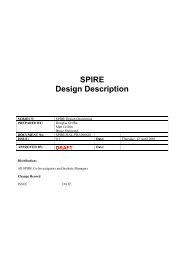gambling in alberta - Research Services - University of Lethbridge
gambling in alberta - Research Services - University of Lethbridge
gambling in alberta - Research Services - University of Lethbridge
Create successful ePaper yourself
Turn your PDF publications into a flip-book with our unique Google optimized e-Paper software.
It is also <strong>in</strong>structive to look at the association between level <strong>of</strong> <strong>gambl<strong>in</strong>g</strong> <strong>in</strong>volvement and level<br />
<strong>of</strong> happ<strong>in</strong>ess and stress when remov<strong>in</strong>g both problem gamblers and nongamblers from the<br />
analysis. When this is done, no significant association between happ<strong>in</strong>ess and level <strong>of</strong> <strong>gambl<strong>in</strong>g</strong><br />
<strong>in</strong>volvement was found as a function <strong>of</strong> number <strong>of</strong> formats engaged <strong>in</strong> (r = .036, p = .095, 2 tail,<br />
N = 2091); frequency <strong>of</strong> <strong>gambl<strong>in</strong>g</strong> (r = .024, p = .265 N = 2091); or net/w<strong>in</strong> losses on <strong>gambl<strong>in</strong>g</strong> (r<br />
= -.022, p = .350, N = 1885). Similarly, no significant association between level <strong>of</strong> stress and<br />
level <strong>of</strong> <strong>gambl<strong>in</strong>g</strong> <strong>in</strong>volvement was found as a function <strong>of</strong> number <strong>of</strong> formats engaged <strong>in</strong> (r = -<br />
.035, p = .114, 2 tail, N = 2082); or net/w<strong>in</strong> loss on <strong>gambl<strong>in</strong>g</strong> (r = -.014, p = .548, 2 tail, N =<br />
1877). However, there was a significant negative association between level <strong>of</strong> stress and<br />
frequency <strong>of</strong> <strong>gambl<strong>in</strong>g</strong> (<strong>in</strong>dicat<strong>in</strong>g a higher frequency <strong>of</strong> <strong>gambl<strong>in</strong>g</strong> is associated with lower<br />
stress) (r = -.093, p = .000022, 2 tail, N = 2082). The percentage <strong>of</strong> variance accounted for with<br />
this latter result is very small, however (less than 1%).<br />
In general, the impact that <strong>gambl<strong>in</strong>g</strong> has on quality <strong>of</strong> life and subjective well-be<strong>in</strong>g is very<br />
difficult to establish. What the present results <strong>in</strong>dicate is that nongamblers are somewhat<br />
more likely to be ‘very happy’ compared to gamblers and that over <strong>in</strong>volvement <strong>in</strong> <strong>gambl<strong>in</strong>g</strong><br />
(i.e., problem <strong>gambl<strong>in</strong>g</strong>) is associated with less happ<strong>in</strong>ess and more stress. When exclud<strong>in</strong>g<br />
nongamblers and problem gamblers from the analysis, there is no significant association<br />
between level <strong>of</strong> <strong>gambl<strong>in</strong>g</strong> <strong>in</strong>volvement and level <strong>of</strong> happ<strong>in</strong>ess and essentially no mean<strong>in</strong>gful<br />
association between level <strong>of</strong> stress and level <strong>of</strong> <strong>gambl<strong>in</strong>g</strong> <strong>in</strong>volvement.<br />
Socioeconomic Inequality<br />
Virtually all prior studies <strong>of</strong> <strong>gambl<strong>in</strong>g</strong> have found it to be regressive, with lower <strong>in</strong>come people<br />
contribut<strong>in</strong>g proportionally more to <strong>gambl<strong>in</strong>g</strong> revenue than higher <strong>in</strong>come people, although the<br />
average amounts contributed tend to <strong>in</strong>crease with <strong>in</strong>come group (Williams, Rehm & Stevens,<br />
2011).<br />
Similarly, the most recent data from Statistics Canada Survey <strong>of</strong> Household Spend<strong>in</strong>g (SHS),<br />
seen <strong>in</strong> Table 37, suggests that although lower <strong>in</strong>come Canadians report a slightly lower<br />
average amount <strong>of</strong> <strong>gambl<strong>in</strong>g</strong> expenditure, as a proportion <strong>of</strong> total <strong>in</strong>come it represents a higher<br />
percentage than higher <strong>in</strong>come groups (Marshall, 2010). (Note: as mentioned earlier, there is<br />
a poor match between reported household expenditure on <strong>gambl<strong>in</strong>g</strong> <strong>in</strong> the SHS relative to<br />
actual revenue per household (e.g., Alberta households reported spend<strong>in</strong>g $363 <strong>in</strong> 2008 on<br />
<strong>gambl<strong>in</strong>g</strong> compared to approximately $2,000 per household <strong>in</strong> actual revenue). Nonetheless,<br />
because the bias/flaws <strong>in</strong> the question word<strong>in</strong>g are similar across <strong>in</strong>come groups, comparisons<br />
between <strong>in</strong>come groups may still be valid).<br />
152
















